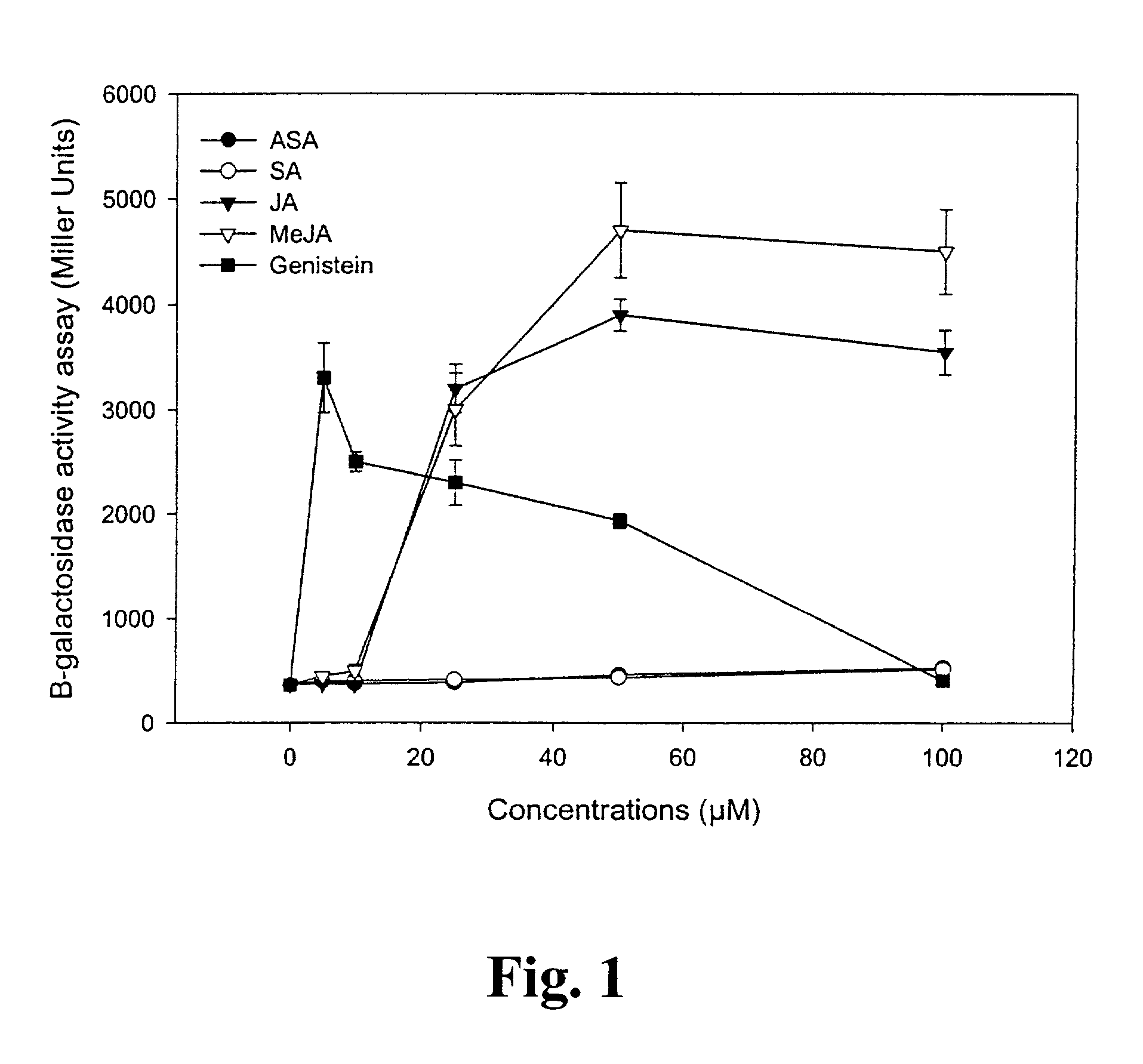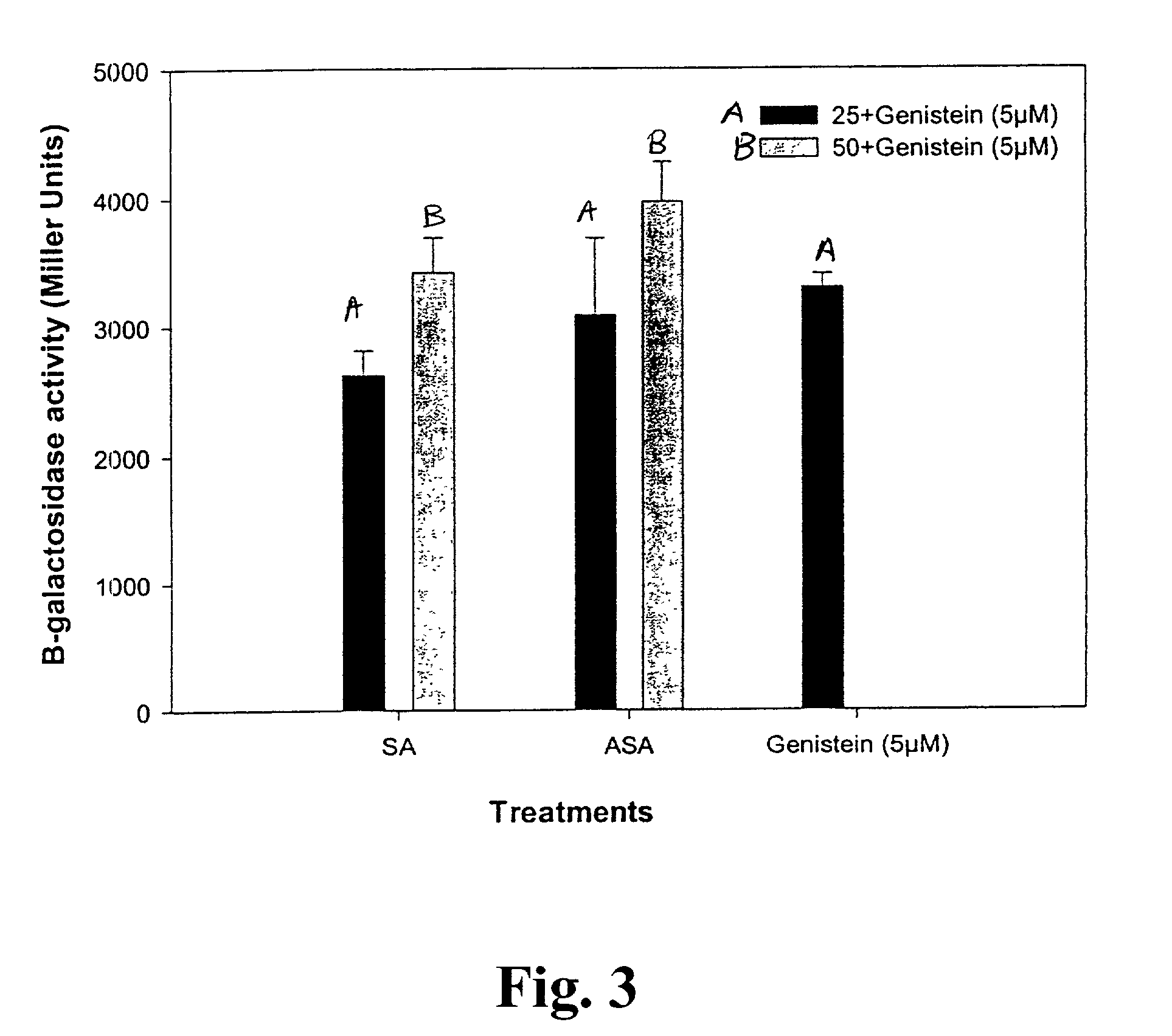Methods and compositions for production of lipo-chito oligosaccharides by rhizobacteria
a technology of lipochito oligosaccharides and rhizobacteria, which is applied in the field of microorganisms, can solve problems such as delayed nodulation onset, and achieve the effect of promoting nitrogen fixation
- Summary
- Abstract
- Description
- Claims
- Application Information
AI Technical Summary
Benefits of technology
Problems solved by technology
Method used
Image
Examples
example 1
Experiment 1
[0065]This experiment evaluated the effect of salicylates and fatty acids including jasmonic acid and its methyl ester, methyl jasmonate, and on the induction of nod genes in Bradyrhizobium japonicum strain USDA3.
Bacterial Strains
[0066]Bradyrhizobium japonicum strain USDA3, harboring plasmid GG4, was used in the experiment. Plasmid GG4 contains a translational fusion between B. japonicum nod Y open-reading frame and lac Z of Escherichia coli. Hence, the nod gene expression activity due to various inducers was indirectly measured by the amount of β-galactosidase activity.
Bacterial Growth and Incubation
[0067]Bacteria were grown in yeast extract mannitol (YEM) medium (mannitol 10.0 g, K2HPO4 0.5 g, MgSO4.7H2O 0.2 g, NaCl 0.1 g, and yeast extract 0.4 g dissolved in 1000 mL of dd H2O). In order to ensure the maintenance of the strains, tetracycline was added to the bacterial cultures at a concentration of 20 mg 1−1. One hundred mL cultures of each strain, in 250 mL flasks, we...
experiment 2
[0071]This experiment was conducted to evaluate the effect of jasmonates on the production of lipo-chito oligosaccharides (LCOs) from Bradyrhizobium japonicum USDA 3.
Bacterial Culture and Incubation
[0072]Bradyrhizobium japonicum (strain USDA 3) was grown at 28° C. in yeast extract mannitol medium (YEM) (mannitol 10 g, K2HPO4 0.5 g, MgSO4.7H2O 0.2 g, NaCl 0.1 g, yeast extract 0.4 g, and distilled water 1000 ml), pH 6.8, shaken at 150 rpm until the OD620 reached 0.4-0.6 (4-6 d) in the dark. Thereafter, 2.0 l of bacterial subculture was started by inoculating with material from the first culture (5 ml of the first culture per 250 ml of YEM media), until the OD620 reached to 0.2-0.4. At this stage, methyl jasmonate, jasmonic acid and genistein were added to culture so that the final concentraton for methyl jasmonate and jasmonic acid was 5, 10, 25, 50 and 100 μM and 5 μM for genistein. The culture was incubated for 48-96 h and the LCO extracted according to the following procedure.
Extra...
example 2
[0085]This experiment was conducted to evaluate nod gene induction by jasmonates in various Bradyrhizobium japonicum strains.
[0086]The effect of 0-100 μM concentrations of each of acetylsalicylic acid, salicylic acid, jasmonic acid, methyl jasmonate, and genistein, on induction of nod gene expression in Bradyrhizobium japonicum strains USDA31, USDA76, USDA121, and USDA3, was evaluated in accordance with the β-galactosidase assay of Experiment 1 in Example 1 above.
[0087]As shown in Table 1, induction of nod gene expression by jasmonic acid and methyl jasmonate was much greater in strain USDA3 than in the other strains tested, particularly at concentrations of jasmonic acid or methyl jasmonate between 25-100 μM. Moreover, methyl jasmonate had a substantially greater inducing effect than jasmonic acid.
[0088]
TABLE 1Differential nod gene induction response of Bradyrhizobium japoniucm strains to jasmonatesConc. (μM)ASASAJAMeJAGENUSDA31 (GG1)0522.6 ± 15.9522.6 ± 15.9522.6 ± 15.9522.6 ± 15....
PUM
| Property | Measurement | Unit |
|---|---|---|
| Temperature | aaaaa | aaaaa |
| Temperature | aaaaa | aaaaa |
| Temperature | aaaaa | aaaaa |
Abstract
Description
Claims
Application Information
 Login to View More
Login to View More - R&D
- Intellectual Property
- Life Sciences
- Materials
- Tech Scout
- Unparalleled Data Quality
- Higher Quality Content
- 60% Fewer Hallucinations
Browse by: Latest US Patents, China's latest patents, Technical Efficacy Thesaurus, Application Domain, Technology Topic, Popular Technical Reports.
© 2025 PatSnap. All rights reserved.Legal|Privacy policy|Modern Slavery Act Transparency Statement|Sitemap|About US| Contact US: help@patsnap.com



